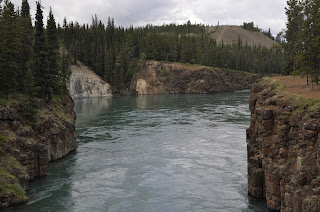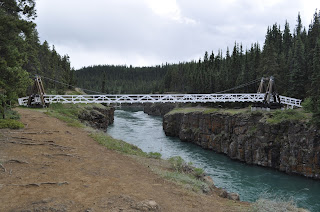Critter watching was fruitful, too. We saw seals and otters (really laying on their backs in the water with rocks to crack shellfish open). We also saw porpoise and a whale.
We sailed on the Jenny Linn, with Chris as our captain. We had a lightly overcast day with little wind. As a result the temperatures were cool and there was no risk of sunburn. The water was smooth, so there was no rocking and rolling. All this made for really fine fishing.
We began by fishing for rockfish along a rocky ledge. You are allowed to keep a combination of rockfish species up to four. There are black bass , red snapper, and a fish called a yelloweye. I was able to catch four black bass and also caught a big halibut, approximately 60 pounds. That is a huge fish to reel in! That nearly completed my limit for the day by 10:30 in the morning. The others also caught their limit of rockfish. We moved to deeper waters and continued fishing for halibut. I was allowed one more halibut under 29 inches long. Naturally the ones I hooked had to be released because they were too big. However, fishing slowed way down as fishing will do and we spent several hours fishless. Then shortly before it was time to go, we began to catch a few. I finally got my last halibut and the fellow who had released a moderate sized fish and was looking at going home empty handed caught the largest fish of the day, about 90 pounds. Now, a 90 pound fish will really fill up a boat, especially when he is unhappy and flopping all over the place. That guy also caught a skate which we released right away without removing from the water. No one wanted to argue with a four foot long ray.
 |
| A happy fishing trip |
When it was said and done, I ended up with 50 pounds of black bass and halibut fillets. That's a lot of fish. Unfortunately, I was not able to take any pictures because the boat deck was too high when you were in the cabin and when you were on deck, you were busy fishing or getting out of the way.
On the way back in to the harbor, we passed an oil tanker heading out to sea. Valdez is the end of the trans-Alaska pipeline (more info and pictures), a really amazing thing. One of the people on the boat worked in the oil fields and he described how the get the tankers out of Valdez after what happened to the Exxon Valdez. So, you have a giant oil tanker steaming down the center of the waterway. It takes miles to stop the thing and huge distances to turn it. The waterway is large, but not that large. Behind the tanker is a red tug boat connected by a cable to the tanker's stern. This is the power tug and it is connected backwards. That is, the stern of the tug boat faces the stern of the tanker. Way behind the red tugboat is a yellow tugboat connected with its bow facing the red tugboat's bow. This is the steering tugboat. If something goes wrong, the red tugboat has huge engines that can slow or stop the tanker. If they need to change direction quickly, the yellow tugboat has a special propeller that can turn all the way around and face in any direction. It drags the tanker sideways.
So all this was going along with the engines of all three running. It was an amazing parade. When the oil tanker gets out to the entrance to Prince William Sound, it disconnects from the tugs and goes on out to sea. Wow, I wonder what it costs to take a shipload of oil to the Pacific Ocean.
Another interesting tidbit. You may remember from your history that Captain Cook originally explored this area in 1778 (more info). Well he had a lieutenant named Bligh, who later became the famous Captain Bligh of the Bounty (remember the Mutiny on the Bounty?). Bligh managed to run a ship aground on the shoals at the mouth of the inlet where Valdez is today. They were named the Bligh reef and the island next to them was named Bligh Island. That is where the Exxon Valdez ran aground. Our fishing trip went between Bligh Island and the mainland down to Port Fildago. Here is a map that shows all this. So since I didn't take pictures, you get a lot of links. I hope you enjoy this little lesson about Alaska.




















































